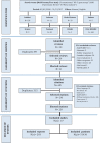Incontinence after laparoscopic radical prostatectomy: a reverse systematic review
- PMID: 35168312
- PMCID: PMC9060170
- DOI: 10.1590/S1677-5538.IBJU.2021.0632
Incontinence after laparoscopic radical prostatectomy: a reverse systematic review
Abstract
Purpose: To report the prevalence of the definitions used to identify post-prostatectomy incontinence (PPI) after laparoscopic radical prostatectomy (LRP), and to compare the rates of PPI over time under different criteria.
Materials and methods: In the period from January 1, 2000, until December 31, 2017, we used a recently described methodology to perform evidence acquisition called reverse systematic review (RSR). The continence definition and rates were evaluated and compared at 1, 3, 6, 12, and >18 months post-operative. Moreover, the RSR showed the "natural history" of PPI after LRP.
Results: We identified 353 review articles in the systematized search, 137 studies about PPI were selected for data collection, and finally were included 203 reports (nr) with 51.436 patients. The most used criterion of continence was No pad (nr=121; 59.6%), the second one was Safety pad (nr=57; 28.1%). A statistically significant difference between continence criteria was identified only at >18 months (p=0.044). From 2013 until the end of our analysis, the Safety pad and Others became the most reported.
Conclusion: RSR revealed the "natural history" of PPI after the LRP technique, and showed that through time the Safety pad concept was mainly used. However, paradoxically, we demonstrated that the two most utilized criteria, Safety pad and No pad, had similar PPI outcomes. Further effort should be made to standardize the PPI denomination to evaluate, compare and discuss the urinary post-operatory function.
Keywords: Prostatic Neoplasms; Prostatectomy; Systematic Reviews as Topic; Urinary Incontinence.
Copyright® by the International Brazilian Journal of Urology.
Conflict of interest statement
None declared.
Figures



Similar articles
-
Systematic review and meta-analysis of studies reporting urinary continence recovery after robot-assisted radical prostatectomy.Eur Urol. 2012 Sep;62(3):405-17. doi: 10.1016/j.eururo.2012.05.045. Epub 2012 Jun 1. Eur Urol. 2012. PMID: 22749852
-
Continence criteria of 193 618 patients after open, laparoscopic, and robot-assisted radical prostatectomy.BJU Int. 2024 Jul;134(1):13-21. doi: 10.1111/bju.16180. Epub 2023 Sep 28. BJU Int. 2024. PMID: 37713071
-
Conservative management for postprostatectomy urinary incontinence.Cochrane Database Syst Rev. 2007 Apr 18;(2):CD001843. doi: 10.1002/14651858.CD001843.pub3. Cochrane Database Syst Rev. 2007. Update in: Cochrane Database Syst Rev. 2012 Jan 18;1:CD001843. doi: 10.1002/14651858.CD001843.pub4. PMID: 17443512 Updated.
-
Retropubic, laparoscopic, and robot-assisted radical prostatectomy: a systematic review and cumulative analysis of comparative studies.Eur Urol. 2009 May;55(5):1037-63. doi: 10.1016/j.eururo.2009.01.036. Epub 2009 Jan 25. Eur Urol. 2009. PMID: 19185977
-
Sexual function criteria post laparoscopic radical prostatectomy: a reverse systematic review.Int Urol Nephrol. 2022 Sep;54(9):2097-2104. doi: 10.1007/s11255-022-03262-w. Epub 2022 Jun 28. Int Urol Nephrol. 2022. PMID: 35764756
Cited by
-
The effect of perioperative pelvic floor muscle exercise on urinary incontinence after radical prostatectomy: a meta-analysis.Int Braz J Urol. 2023 Jul-Aug;49(4):441-451. doi: 10.1590/S1677-5538.IBJU.2023.0053. Int Braz J Urol. 2023. PMID: 37267610 Free PMC article.
-
Predictors of Urinary Continence Recovery after Laparoscopic-Assisted Radical Prostatectomy: Is Surgical Urethral Length the Only Key Factor?Life (Basel). 2023 Jul 13;13(7):1550. doi: 10.3390/life13071550. Life (Basel). 2023. PMID: 37511925 Free PMC article.
-
Robotic versus open radical Prostatectomy: comparing automobiles and carriages in 2024.Int Braz J Urol. 2024 Nov-Dec;50(6):772-775. doi: 10.1590/S1677-5538.IBJU.2024.0470. Int Braz J Urol. 2024. PMID: 39226446 Free PMC article. No abstract available.
-
Comparative analysis of conventional penile clamps and Uriclak device in managing male incontinence following radical, turp, or laser prostate surgery.Front Surg. 2023 Dec 19;10:1301353. doi: 10.3389/fsurg.2023.1301353. eCollection 2023. Front Surg. 2023. PMID: 38192489 Free PMC article. Review.
-
Treatment of erectile dysfunction by intracavernosal administration of mesenchymal stem cells in patients with diabetes mellitus.Int Braz J Urol. 2024 Jul-Aug;50(4):386-397. doi: 10.1590/S1677-5538.IBJU.2024.0100. Int Braz J Urol. 2024. PMID: 38701187 Free PMC article. Review.
References
-
- Nelson M, Dornbier R, Kirshenbaum E, Eguia E, Sweigert P, Baker M, et al. Use of Surgery for Post-Prostatectomy Incontinence. J Urol. 2020; 203:786-91. - PubMed
-
- Abrams P, Cardozo L, Fall M, Griffiths D, Rosier P, Ulmsten U, et al. The standardisation of terminology of lower urinary tract function: report from the Standardisation Sub-committee of the International Continence Society. Neurourol Urodyn. 2002; 21:167-78. - PubMed
-
- Holm HV, Fosså SD, Hedlund H, Schultz A, Dahl AA. How should continence and incontinence after radical prostatectomy be evaluated? A prospective study of patient ratings and changes with time. J Urol. 2014; 192:1155-61. - PubMed
-
- Ellison JS, He C, Wood DP. Stratification of postprostatectomy urinary function using expanded prostate cancer index composite. Urology. 2013; 81:56-60. - PubMed
-
- Moretti TBC, Magna LA, Reis LO. Development and application of Reverse Systematic Review on laparoscopic radical prostatectomy. Urol Oncol. 2019; 37:647-58. - PubMed
Publication types
MeSH terms
LinkOut - more resources
Full Text Sources
Medical
Miscellaneous
